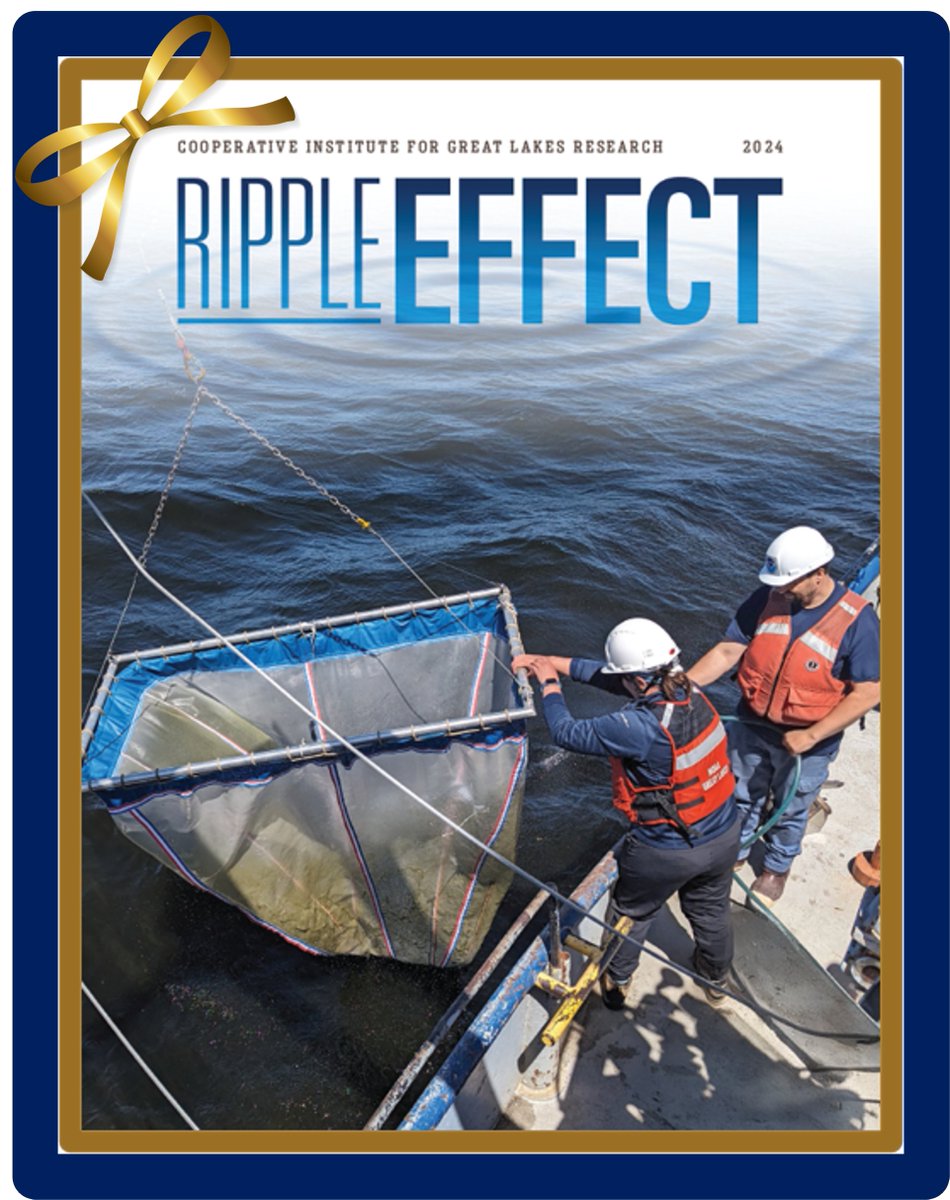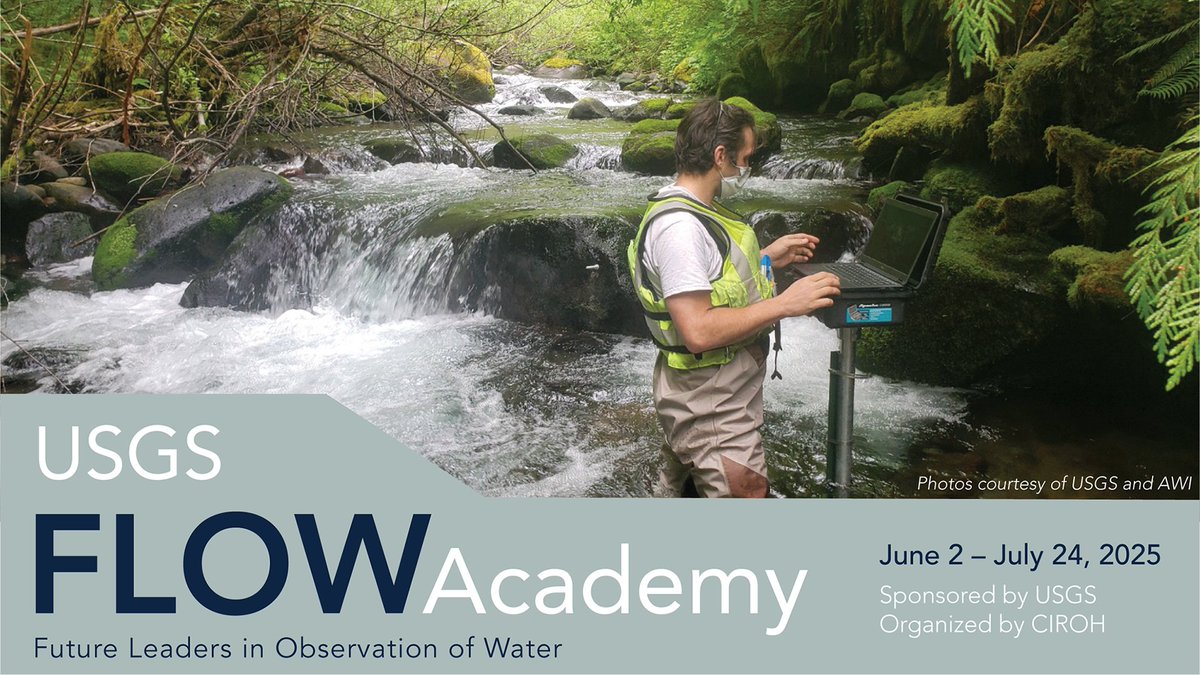
CIGLR
@CIGLR_UM
Followers
4K
Following
35K
Statuses
15K
The Cooperative Institute for Great Lakes Research. Working for the Great Lakes region since 1989, thanks to @NOAA and university partnerships.
Ann Arbor, MI
Joined July 2011
PLEASE SHARE! 📢 One week left to apply for #CIGLR's 2025 #GreatLakes Summer Fellowships! There are 7 full-time, 12-week positions paying $10,000 each. Applications are due 09 Feb 2025 at 11:59 pm EST! Eligibility & how to apply:
0
1
2
Come join us TODAY at the @UMich League for the @UMSEAS Green Career Fair! We are talking about all of the upcoming #GreatLakes opportunities with #CIGLR and we look forward to seeing you!
0
1
2
#HIRING! 1 day to apply for #CIGLR's Molecular Ecology Postdoc! Candidate will work w/ dynamic research team to develop tools for eDNA analysis of food web dynamics, invasive species, biodiversity &/or toxic cyanobacteria in the #GreatLakes. Apply by 2/1:
0
0
3
PLEASE SHARE! 📢 #CIGLR is excited to announce the opening of our 2025 #GreatLakes Summer Fellow applications! There are 7 full-time, 12-week positions paying $10,000 each. Applications are due 09 Feb 2025 at 11:59 pm EST! Eligibility & how to apply:
0
2
5
RT @LampreyControl: #DYK that #sealamprey populations have been reduced by ~90% across the #GreatLakes? Before control, there were ~2.5 million sea lampreys in the lakes. Nowadays, sea lamprey populations are a small fraction of what they once were.
#DYK that #sealamprey populations have been reduced by ~90% across the #GreatLakes? Before control, there were ~2.5 million sea lampreys in the lakes. Nowadays, sea lamprey populations are a small fraction of what they once were. #InvasiveSpecies #SciComm
0
0
1
#ICYMI: Strong winds were creating big waves on the #GreatLakes yesterday, reaching up to 22 feet in #LakeSuperior and #LakeOntario. Latest NCEP WaveWatch III graphics: #GreatLakesSci #GreatLakesNews
Hold onto your hats!! Strong winds are creating big waves in the #GreatLakes today and tonight, reaching up to 22 feet in #LakeSuperior and #LakeOntario. Latest NCEP WaveWatch III graphics: #GreatLakes #GreatLakesSci
0
0
0
Ahead of a Feb. 4 congressional briefing on #GreatLakes science, @UMich experts including #CIGLR's Mike Shriberg, Ayumi Fujisaki-Manome & Casey Godwin are available to speak on trends in policy, weather, water quality & more in the world’s largest freshwater system. More below 👇
Ahead of a Feb. 4 congressional briefing on #GreatLakes science, @UMich experts are available to speak on trends in policy, weather, water quality and more in the world’s largest freshwater system. Mike Shriberg is a professor of practice and engagement at @UMSEAS and associate director of @CIGLR_UM. CIGLR is co-hosting the briefing and Shriberg will be a panelist. He is also engagement director at Michigan Sea Grant and previously served as Great Lakes regional executive director for the @NWF and co-chair of the Healing Our Waters-Great Lakes Coalition. His expertise is on Great Lakes water policy and politics. “The Great Lakes are the great uniters of the region. But climate change, environmental injustice and partisan politics are pulling at the seams of this unity, creating chaos in the ecosystem and our social systems,” Shriberg said. “The first few months of this new presidential administration and congress will be a test of how unified support is for the Great Lakes Restoration Initiative, which has traditionally enjoyed the most bipartisan support of any environmental issue in the region, and perhaps the nation. “Funding for drinking water and wastewater infrastructure has also traditionally enjoyed widespread support but will likely face significant resistance in the current political environment. In addition, I expect the strength of and support for the Clean Water Act, which was passed in large part due to pollution in the Great Lakes, to be severely challenged. Whether the Great Lakes and water protection can continue to be a uniting force in Michigan and across the region will be tested in novel ways over the coming months and years.” -------------------------- Ayumi Fujisaki-Manome is an associate research scientist at the Cooperative Institute for Great Lakes Research at the School for Environment and Sustainability, a collaboration with @NOAA's Great Lakes Environmental Research Laboratory. She is also an adjunct associate research scientist in climate and space sciences and engineering at the College of Engineering. Her research aims to improve our ability to predict hazardous weather, ice and water events in cold regions to better support coastal communities. “In the Great Lakes region, we are seeing colder-than-normal weather in early-to-mid January. While this has helped lake ice form in limited areas, such as bays, the water surface temperature remains above average due to the much warmer conditions experienced in the past months,” Fujisaki-Manome said. “Sustained cold air is needed for lake ice to develop further and reach levels typical of normal years. The El Niño-Southern Oscillation, whose positive phase usually brings warmer winters to the Great Lakes region, has switched to its negative phase. This shift may indicate the potential for more winter-like weather, with colder conditions. However, it also suggests the possibility of a wetter winter. Historical trends show that winter storms crossing the Great Lakes tend to carry more moisture. This long-term trend, along with potential anomalies, could lead to a wet winter for the region.” -------------------------- Jennifer Read is director of the Water Center in the @GrahamInstitute, which fosters collaborative research that informs the policy and management decisions affecting the Great Lakes and coastal estuarine waters. She was previously assistant director and research coordinator of Michigan Sea Grant and has held positions at the Great Lakes Commission and the Great Lakes Institute for Environmental Research. She currently serves on the advisory board for Great Lakes Blue Accounting and the federal advisory committee for the U.S. Integrated Ocean Observing System. “In the dead of winter, it’s easy to forget that harmful algal blooms, or HABs, remain a pressing concern for the Great Lakes, with blooms detected in Lake Superior for the first time last year,” Read said. “Algal blooms threaten recreation, public health and local economies. “While scientific advancements provide valuable tools to address HABs, eutrophication and other water quality challenges, they cannot solve the problem alone. Protecting Great Lakes water quality requires cross-sector collaboration to address the human behaviors and practices driving pollution. By uniting our efforts, we can safeguard the Great Lakes and ensure clean and accessible water for everyone.” -------------------------- Gregory Dick is director for the Cooperative Institute for Great Lakes Research and director of the Great Lakes Center for Freshwaters and Human Health. He is also an Alfred F. Thurnau Professor at @MichiganEarth and the School for Environment and Sustainability. His research focuses on the role of microorganisms in shaping environmental processes, water quality and biogeochemistry. His lab is currently studying the microbial ecology of harmful cyanobacterial blooms that threaten freshwater ecosystems around the world, using Lake Erie as a natural laboratory. “Harmful algal blooms continue to be a persistent threat to the Great Lakes. In one of the biggest regions of concern, the Western Basin of Lake Erie, monitoring programs now mitigate the harm, and some progress has been made in management of the nutrients that cause algae blooms, but they continue to occur at levels that are unacceptable,” Dick said. “Meanwhile, climate change appears to be exacerbating the issue and facilitating their spread; we now see harmful algal blooms in all five Great Lakes. We are also still working to understand what algal toxins are present, what controls their production, and their impacts on human health.” -------------------------- Silvia Newell is director of Michigan Sea Grant and professor at the School for Environment and Sustainability. She is a nutrient biogeochemist and microbial ecologist whose research focuses on the effects of excess nutrients from fertilizer and wastewater on inland and coastal waters, particularly harmful algal blooms, or HABs. Her current collaborative work in the Lake Erie watershed focuses on engaging stakeholders—farmers, managers and policymakers—to develop realistic pathways for nutrient reduction. “Harmful algal blooms in the western basin of Lake Erie have persisted at medium severity over the last few years,” Newell said. “Overall, dissolved nutrient loading and water discharge to Lake Erie have been declining over the past five years, and precipitation has also decreased during the loading season. “While soluble reactive phosphorus loading from the Maumee River has been lower, the research community is still working to understand how much of the decline is because of reduced discharge compared with implementation of several new management practices in the watershed. The real test of management practices will occur during the next wet year, especially as storms are becoming more intense.” -------------------------- Casey Godwin is an associate research scientist in the School for Environment and Sustainability and part of the Cooperative Institute for Great Lakes Research. His group works closely with NOAA’s Great Lakes Environmental Research Laboratory on monitoring, experiments and modeling related to harmful algal blooms, hypoxia and changing nutrient dynamics in the lakes. “The timings of ice cover, water temperature and nutrient runoff are rapidly changing and becoming more variable between years. These drivers can affect processes in the lakes and problems including harmful algal blooms and hypoxia, but a historical lack of data and observations between November through March each year limits our ability to quantitatively connect changing winter to those ongoing problems,” Godwin said. “Scientists around the lakes are racing to study processes in winter, but those harsh conditions make it a logistically difficult period of the year to study. The past few years have greatly accelerated our observations of the lakes during the colder months, thanks to collaborative winter sampling by institutions around the lakes, limited sampling aboard vessels when safe to do so, and new instruments that give us samples and measurements even when it would not be possible to venture out on the lakes by boat or on ice.”
0
0
0
🌊 Ready to dive into water research? Apply to the USGS FLOW Academy (June 2–July 24, 2025) for a hands-on, 7-week experience tackling real-world water challenges.💧 more information 👇 @UA_CIROH
🌊 Ready to dive into water research? Apply to the USGS FLOW Academy (June 2–July 24, 2025) for a hands-on, 7-week experience tackling real-world water challenges. 💧 🖱️ Apply by Jan. 27: #USGS #FLOWAcademy #STEM
@AlabamaWater @USGS @USGS_Water
0
0
1
RT @NOAA_GLERL: Heading into the weekend with 23.2% ice cover on the #GreatLakes. #LakeErie has seen rapid ice growth this week, jumping from 38% on Monday to 85% now! Current ice on the rest of the lakes: Sup: 8.2% Mich: 21.5% Hur: 25.3% Ont: 13.4%
Heading into the weekend with 23.2% ice cover on the #GreatLakes. #LakeErie has seen rapid ice growth this week, jumping from 38% on Monday to 85% now! Current ice on the rest of the lakes: Sup: 8.2% Mich: 21.5% Hur: 25.3% Ont: 13.4% Ice graphs & stats:
0
2
2
RT @umichdpss: Going out into the cold weather? Find out what you should be wearing and how to stay as safe as possible from the elements by clicking here:
Going out into the cold weather? Find out what you should be wearing and how to stay as safe as possible from the elements by clicking here:
0
0
0
RT @NWS: You have been hearing plenty about wind chill the past few days. Extremely cold air affects millions every winter & even spring. Arctic air, together w/ brisk winds, can lead to dangerously cold wind chill, leading to losing body heat quickly;
Many of you have been hearing plenty about wind chill the past few days. Extremely cold air affects millions of people across the United States every winter and even into parts of the spring. This Arctic air, together with brisk winds, can lead to dangerously cold wind chill values, which can cause your body to lose heat quickly. Read more about the science of wind chill at
0
0
2
THIS WEDNESDAY "All Too Clear" opens the Thunder Bay International Film Festival! More 👇
THIS WEDNESDAY "All Too Clear" opens the Thunder Bay International Film Festival! Join us at the historic Rogers City Theatre in Michigan. Tickets just $10 – get yours now before they sell out! @friendsTBNMS @ThunderBayNMS
0
0
0
🚨RESCHEDULED!🚨 The #GreatLakes #seminar titled: "Representing Lake-Atmosphere Interactions in NOAA’s Weather Prediction Models" by Christiane Jablonowski will now take place March 4, 2025 at 11am. For registration and more: #GreatLakesSci #Webinar
0
1
4
On this #MLKDay, U-M’s 2025 MLK Symposium explores the theme “Restless Dissatisfaction: An Urgent Call for the Pursuit of Justice and Equality.” Event schedule and livestream here:
0
1
1
RT @UMBS: Students, build your field skills through intensive, adventurous four-week courses at the @UMich Biological Station during spring and summer terms. We have lots of scholarships available for students from all universities & colleges. Apply today!
Students, build your field skills through intensive, adventurous four-week courses at the @UMich Biological Station during spring and summer terms. We have lots of scholarships available for students from all universities and colleges. Apply today!
0
1
1
#CIGLR is in New Orleans, LA for the 105th #AMS2025 meeting! A big THANK YOU to everyone who attended our sessions 🙌 it's been great to share our latest #GreatLakesSci & to collaborate w/ experts to advance weather, water & climate science & service. #AMS #GreatLakes @NOAA_GLERL
0
1
5
RT @NOAA: NOAA satellites were pivotal in the rescue of 411 lives in 2024. Learn about SARSAT — the Search and Rescue Satellite Aided Tracking system — and how NOAA relays life-saving information to aid in land and maritime rescues: @NOAASatellites
NOAA satellites were pivotal in the rescue of 411 lives in 2024. Learn about SARSAT — the Search and Rescue Satellite Aided Tracking system — and how NOAA relays life-saving information to aid in land and maritime rescues: @NOAASatellites
0
0
0
RT @MNSeaGrant: 📚Formal & non-formal 5–12th-grade educators in #GreatLakes states—don’t miss this chance to join the Center for Great Lakes Literacy & scientists for a hands-on #LakeMichigan workshop, July 7–13, 2025! 🗓️ Apply by Feb. 10, 2025:
📚Formal & non-formal 5–12th-grade educators in #GreatLakes states—don’t miss this chance to join the Center for Great Lakes Literacy & scientists for a hands-on #LakeMichigan workshop, July 7–13, 2025! 🗓️ Apply by Feb. 10, 2025: #GLRI #NOAA #STEM
0
0
2









































